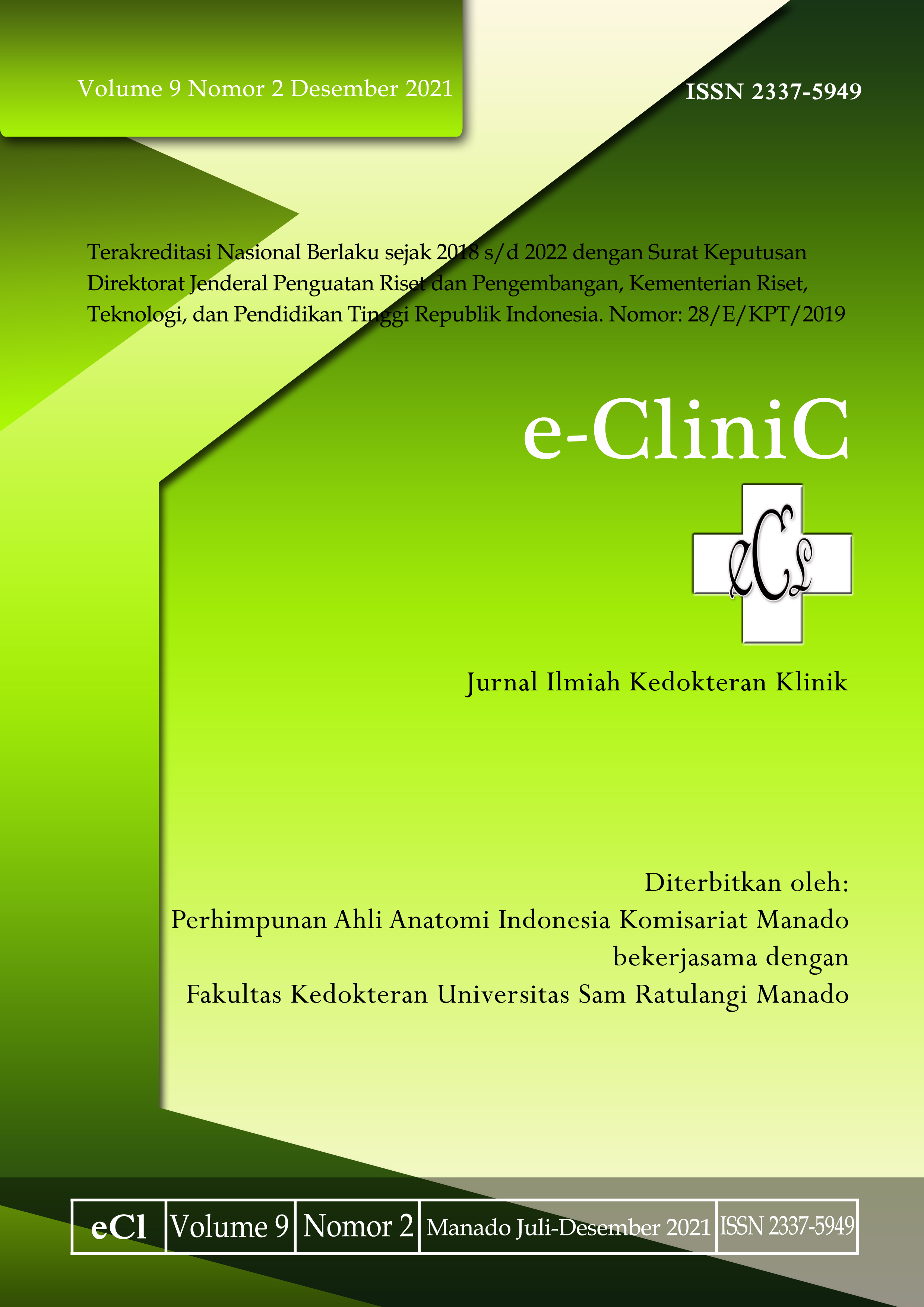Efek terapi oksigen hiperbarik terhadap nilai Montreal Cognitive Assesment Indonesia (MoCA-INA) pada pasien cedera otak traumatik ringan
DOI:
https://doi.org/10.35790/ecl.v9i2.35947Abstract
Abstract: Hyperbaric oxygen therapy (HBOT) uses 100% oxygen at a pressure of more than 1 ATM in a chamber, therefore, it can improve the state of tissue hypoxia. This study was aimed to prove that TOHB could increase the MoCA-INA score in mild traumatic brain injury (mTBI). This study was carried out at the Surgery Department of Prof. Dr. R. D. Kandou Hospital, Manado using the pre and post trial design. Subjects were 20 patients with mTBI divided into two groups: treated with HBOT and control group (without HBOT). Each patient involved would be examined for MoCA-INA before and after treatment or with HBOT added. The results showed that before treatment, the MoCA-INA scores tended to be evenly distributed around 36 (SD 5). The score increased to 71 (SD 10) at post-injury management or a mean increase of 35 points (p<0.001 in the paired two-sample t-test). However, there was no significat difference in MoCA-INA scores between the first and the second measurements. The density of the two groups clearly overlapped even though the variation of MoCA-INA scores of the HBOT group was much wider than that of the control group (p=0.302 and 0.297 in the first and second measurements, respectively). There was no cognitive disturbance either mild, moderate, or severe in all patients. In conclusion, there was an increase of the MoCA-INA value in mTBI patients after treatment. The patients treated with HBOT showed wider variation of MoCA-INA score of pre and post HBOT than those without HBOT
Keywords: HBOT; mTBI; MoCA-INA; cognitive function
Â
Abstrak: Terapi oksigen hiperbarik (TOHB) menggunakan oksigen 100% pada tekanan lebih dari 1 ATM dalam sebuah chamber sehingga dapat memperbaiki keadaan hipoksia jaringan. Penelitian ini bertujuan untuk membuktikan bahwa TOHB dapat meningkatkan nilai MoCA-INA pada pasien cedera otak traumatik ringan (COTr). Penelitian dilaksanakan di Bagian Bedah RSUP Prof. Dr. R. D. Kandou, Manado dengan menggunakan pre and posttrial design. Subyek penelitian ialah 20 pasien COTr dibagi dalam dua kelompok: dengan dan tanpa TOHB (kelompok kontrol). Setiap subyek diperiksa MoCA-INA sebelum dan sesudah penatalaksanaan cedera/disertai TOHB. Sebelum penatalaksanaan cedera, rerata skor MoCA-INA sekitar 36 (SD 5) dan nilai tersebut meningkat menjadi 71 (SD 10) pasca penatalaksanaan cedera atau kenaikan rerata 35 poin (p<0,001 pada uji t dua sampel berpasangan). Tidak tampak perbedaan skor MoCA-INA baik pada pengukuran pertama maupun kedua. Densitas kedua kelompok terlihat jelas tumpang tindih sekalipun variasi skor MoCA-INA group TOHB jauh lebih lebar daripada group kontrol (p=0,302 dan 0,297 masing-masing pada pengukuran pertama dan kedua). Tidak terlihat adanya gangguan kognitif ringan sedang maupun berat pada semua pasien. Simpulan penelitian ini ialah terdapat peningkatan nilai MoCA-INA pada pasien COTr. Pasien dengan TOHB memperlihatkan variasi skor MoCA-INA yang lebih besar pada pre dan pasca TOHB.
Kata kunci: TOHB; COT; MoCA-INA; gangguan kognitif
Downloads
Published
How to Cite
Issue
Section
License
COPYRIGHT
Authors who publish with this journal agree to the following terms:
Authors hold their copyright and grant this journal the privilege of first publication, with the work simultaneously licensed under a Creative Commons Attribution License that permits others to impart the work with an acknowledgment of the work's origin and initial publication by this journal.
Authors can enter into separate or additional contractual arrangements for the non-exclusive distribution of the journal's published version of the work (for example, post it to an institutional repository or publish it in a book), with an acknowledgment of its underlying publication in this journal.
Authors are permitted and encouraged to post their work online (for example, in institutional repositories or on their website) as it can lead to productive exchanges, as well as earlier and greater citation of the published work (See The Effect of Open Access).







